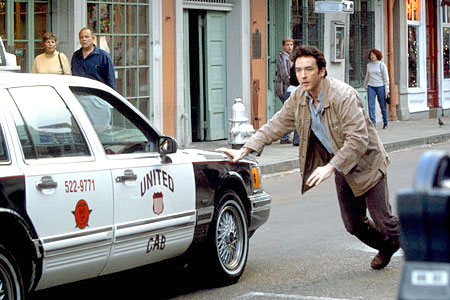In a Times-Picayune article from October 2003, Runaway Jury director Gary Feldman said, “I couldn’t imagine shooting Runaway Jury anywhere but New Orleans.”The question of return on tax-payer investment has been a source of debate since the implementation of the tax credit program in 2002. In particular, the impact of the film economy on cultural tourism is difficult to quantify. Feldman emphasizes creative decisions that led to New Orleans being selected for the film: “For the movie, the city itself is such a great dichotomy of being sort of rich and beautiful and historic, but also darker and shadowed by a history of corruption and violenc so I think the duality of the film was reflected by the duality of the city” (Kleinschrodt, Michael. H. “The Big Easy does it right for director and production designer” The Times Picayune, October 17, 2003).
Runaway Jury was a major motion picture adaptation of a best-selling novel by John Grisham, directed by Gary Felder and produced by 20th Century Fox. The film was produced almost exclusively in New Orleans and was the first big budget film to take advantage of the 2002 Motion Picture Tax Incentive Act (Rose, Chris. “Lights! Camera! Jury! Star-studded adaptation of John Grisham’s “Runaway Jury” is in town and in Production.” The Times Picayune, October 12, 2002). The reported budget was $60 million and was considered a “coup for the city and state” (Anderson, Ed. “Major movie to be filmed in the state-Shooting to begin in late September” The Times Picayune, July 19, 2002).
The director called the film “a love letter to New Orleans,” (an expression Brad Pitt later used to describe The Curious Case of Benjamin Button ) and said the location scouts went out of their way to find “the best streets” and “out of the way restaurants,” to use as locations. Similarly, they wanted to show the Mississippi River to give a nod to New Orleans’ history as a river town. Production designer Nelson Coates noted, “it could have been easy to film this and never see the river.”
Coates and Felder apparently also hoped to avoid clichéd representations of New Orleans that they felt were common in other films, appealing mainly to the “tourist perception” of the city. A particular example is the notion of everyone in New Orleans having a southern accent, “like in the Big Easy, they all have this thick Cajun accent,” Coates explained (Rose).
Film Synopsis and Re-setting in New Orleans

John Cusak in the French Quarter in “Runaway Jury”. Photo courtesy of Twentieth Century Fox.
The film was a legal thriller featuring an all-star cast including John Cusack, Rachel Weisz, Dustin Hoffman and Gene Hackman. The main story line of both the book and film centers on a young couple’s attempt to rig a jury for motives not revealed until the end of the movie.
Grisham’s novel is set in Biloxi, MS, and the trial pits the widow of a lung cancer victim against Big Tobacco. However, in the film version the setting is New Orleans and the defendant is instead a gun manufacturer. The impetus for the plot changes has been debated. One potential reason is that the Big Tobacco plot paralleled that of the critically acclaimed film “The Insider.” In fact, in 1998 New Orleans became the first city to sue gun manufacturers over the safety of their products. It is unclear from interviews whether the plot and script changes came before or after New Orleans was selected as the production location.
New Orleans was one of several cities competing to woo the film, including Savannah, GA, Richmond, VA, and Memphis, TN. The generous tax incentives established by the 2002 act probably sealed the deal for New Orleans, though it is debated whether or not the producers had already chosen the city before learning the extent of the subsidies (Anderson).
In a newspaper article from July 2002, economic development official Lonny Kaufman is quoted as saying “now that they’re here, they’re finding that they like these incentives.” The same article concludes that producers chose New Orleans in part due to its “unique locations,” and part because of film industry incentives.
Local movie critic Mike Foster suggested that the film would have a “huge impact on the greater New Orleans region.” Certainly Runaway Jury kicked off a new era of film production in New Orleans, incentivized by the 2002 tax credit act. However, it is unclear what sorts of multiplier impacts the film had on the larger local economy, particularly tourism (Mathis, TIm. “Louisiana Film Tax Credits: Costly Giveaways to Hollywood.” Louisiana Budget Project Report, August 2012).
Locations in the film
Runaway Jury was the first major film to use the University of New Orleans’ Robert E. Nims Center for Entertainment Arts a Multimedia Technology, a sound stage behind the Elmwood Shopping Center in Jefferson Parish (Kleinschrodt).
Other locations include: Gallier Hall as the Hoffman Law Firm, a Greek Revival built between 1845-1853 that served as New Orleans City Hall for over a century; the Old Wildlife & Fisheries building in the French Quarter, where the jury room is situated; the London Lodge on Airline Drive, where jury members are sequestered; and Napoleon House, where characters meet throughout the film. An unexpected location choice is the Audubon Place home of Tulane’s president at the timehis library was transformed into the judge’s chambers (Yerton, Stewart. “It’s Showtime.” The Times Picayune, Septemeber 15, 2002, Money sec).





